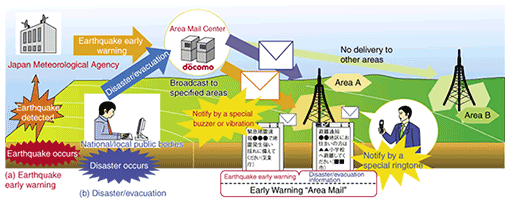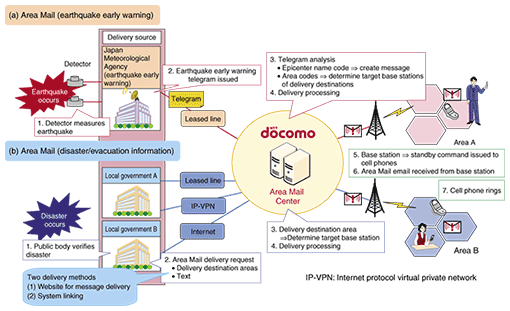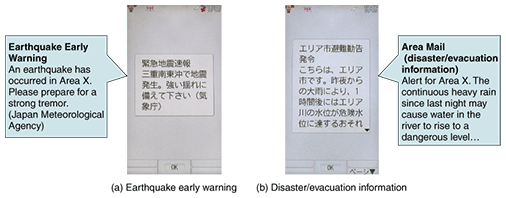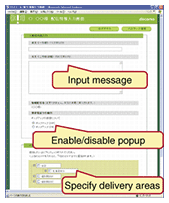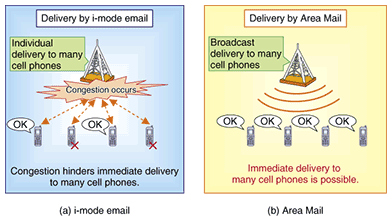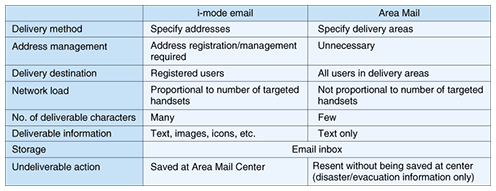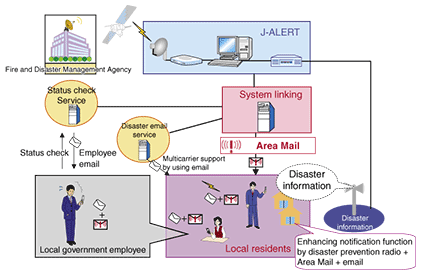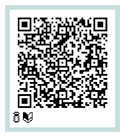 |
|||||||
|
|
|||||||
|
Special Feature: Risk Management and Disaster Prevention Solutions by NTT Group Vol. 6, No. 12, pp. 12–17, Dec. 2008. https://doi.org/10.53829/ntr200812sf2 Early Warning ˇČArea Mail”AbstractNTT DOCOMO has developed Early Warning ˇČArea Mail” using the Cell Broadcast Service (CBS) to broadcast essential information quickly to a large number of people by email. The Area Mail service contributes to a safe and secure infrastructure by delivering earthquake early warnings and disaster and evacuation information to users in potentially affected areas.
1. BackgroundJapan has recently experienced several large-scale earthquakes exceeding a seismic intensity of 6, including the 2004 Niigata Prefecture Chuetsu Earthquake and the 2007 Noto Peninsula Earthquake. These earthquakes were accompanied by significant damage that generated much interest in earthquake countermeasures. Against this background, the ˇČStudy Group on Official Operation of an Earthquake Early Warning System” was launched in 2005 by the Japan Meteorological Agency. Following a limited offering to local public bodies and research institutions from August 1, 2006, the provision of earthquake early warnings for the general public began on October 1, 2007. Earthquake early warnings are not limited to broadcast media such as TV and radio—they are expected to be accessible to everyone in the nation, so they are also provided via communications media such as fixed-line telephones and cell phones. Cell phones, in particular, are the focus of much attention because they enable warnings to be received at any time day or night. There are also expectations for the rapid provision of disaster and evacuation information to residents of a potentially affected area. This could include information about tsunamis, rivers overflowing their banks, and landslides together with directions to evacuation sites. As part of its efforts to achieve a safe and secure society, NTT DOCOMO developed the Early Warning ˇČArea Mail” service to broadcast such emergency information by email and launched the service with its FOMA 905i series of handsets. 2. Service overviewArea Mail is a service that broadcasts earthquake early warnings and disaster and evacuation information to cell phones within potentially affected areas in a short time. It is actually divided into two services according to the content of the information to be delivered, as described below. The service concept is shown in Fig. 1.
2.1 Earthquake early warningArea Mail (earthquake early warning) delivers earthquake early warnings for the general public provided by the Japan Meteorological Agency to NTT DOCOMO cell phones ((a) in Fig. 2). When a seismic wave is detected at two or more earthquake detection points and the maximum seismic intensity is estimated to be just under 5 or greater, the Japan Meteorological Agency will issue an earthquake early warning for the general public to those areas (total number of areas in the country: 200) expected to experience a strong tremor with a seismic intensity of 4 or greater.
The Area Mail Center set up by NTT DOCOMO receives the earthquake early warning from the Japan Meteorological Agency in a telegram via a dedicated line. It then broadcasts the message (in Japanese) ˇČEarthquake Early Warning: An earthquake has occurred in Area X. Please prepare for a strong tremor. (Japan Meteorological Agency)” to base stations in relevant areas. This message can be received on compatible handsets in the areas in question and is brought to the user's attention by a popup window on the handset screen ((a) in Fig. 3) and by a special buzzer tone or vibration. The use of a popup and special ringtone means that the information will be actively brought to the user's attention without the user needing to open the email message.
To avoid user confusion when an Area Mail message is received, a uniform buzzer tone is used by all mobile communications operators. The pitch and frequency band of the buzzer tone have been chosen so that it can be heard outdoors under noisy conditions and by users of all ages. 2.2 Disaster and evacuation informationArea Mail (disaster/evacuation information) can deliver information about disasters and evacuation sites for residents from national and local public bodies that have entered into a contract with NTT DOCOMO ((b) in Fig. 2). A national or local public body that has obtained information about the occurrence of a disaster accesses a website for controlling message delivery (Fig. 4) from a personal computer by using a web browser and inputs a message of up to 515 characters. From this website, the popup display function can be enabled or disabled depending on the importance of the message, and the areas targeted for message delivery may be specified in units of cities, wards, towns, and villages under the jurisdiction of that public body (in this context, there are about 1800 cities, wards, towns, and villages throughout Japan; wards refers only to Tokyo's 23 wards). Based on that information, the Area Mail Center broadcasts the message to base stations within the specified delivery areas.
The message can be received by handsets supporting this service within the areas targeted for delivery. Users are notified that a message has arrived by a popup and a special ringtone ((b) in Fig. 3). This ringtone has been chosen to be different from the special buzzer tone used for earthquake early warnings. An HTTP (hypertext transfer protocol) interface is also provided for Area Mail (disaster/evacuation information) to enable it to link up with other systems and automate the delivery process. 3. Service system and features3.1 System overviewAn earthquake early warning is information that must be provided in a matter of seconds. It must be provided as fast as possible even to cell phones. In addition, earthquake early warnings and disaster/evacuation information must be broadcast to cell phones in the affected region: this requires a network that can handle a local concentration of messages. After an investigation of broadcast-delivery systems that could satisfy these requirements, it was decided to use the Cell Broadcast Service (CBS). The CBS system is a broadcast format defined by the 3rd Generation Partnership Project (3GPP), which prepares international technical specifications for mobile communications. It differs from the circuit-switching mechanism of conventional telephones and the packet-switching system of, for example i-mode, in that it uses signals that control cell phones. 3.2 FeaturesArea Mail has three main features. (1) Delivery to specific areas Area Mail enables base stations targeted for message delivery to be specified from the network side, and messages can be delivered to the large number of unspecified cell phones present within the cells handled by those base stations. An earthquake early warning can be delivered to only those areas for which a strong tremor is predicted. In the event of a disaster other than an earthquake, specific information such as the location of evacuation sites can be delivered to those areas affected by the disaster. Since Area Mail delivers messages to all compatible cell phones in the chosen areas, those messages will reach not only residents but also commuters (to school and work) and tourists visiting those areas. (2) Broadcast delivery in a short time If earthquake early warnings or disaster/evacuation information were to be delivered by i-mode email (packet communications), congestion or delay could be expected, as described below. With i-mode email, messages must be sent out separately to each and every cell phone based on individual email addresses. As a result, network load increases in proportion to the number of handsets targeted for delivery, creating a situation where congestion is likely to occur (Fig. 5(a)). Since congestion can delay the delivery of messages, i-mode email is not suitable for swift mass delivery. Area Mail, on the other hand, performs a one-way simultaneous delivery of messages to cell phones from a base station (broadcast delivery), enabling the delivery of messages in a short time regardless of the number of intended recipients (Fig. 5(b)).
(3) No need to manage destination email addresses When information is delivered by an e-mail system like i-mode email, one issue is how to collect the email addresses of local residents. In addition, any list of email addresses becomes obsolete over time because users tend to change addresses frequently as a countermeasure to spam email, for example. Area Mail works without individual email addresses being collected and it delivers messages to all compatible cell phones that are present at the time in specific areas. These features are of great benefit for delivering earthquake early warnings and disaster/evacuation information to a wide range of people in affected areas. The main differences between i-mode email and Area Mail using CBS are summarized in Table 1.
4. Using Area Mail with other systemsNTT DOCOMO is making proposals to national and local public bodies on various ways of using Area Mail (disaster/evacuation information) and linking it with other systems. A typical example is linking with an employee contact system using i-appli DX. This system uses i-appli messages at the time of Area Mail (disaster/evacuation information) delivery. Here, the distribution of i-appli messages is restricted beforehand to employees of national or local public bodies, and at the time of an Area Mail delivery from such public bodies, local residents will receive ordinary Area Mail while those employees will receive i-appli-generated messages. This system supports replies and status reports, and it can be combined with a GPS (global positioning system) function so that location information can be attached to photographs taken of surrounding conditions, and reports with photographs attached can be submitted. Since it is possible to use i-appli messages from other email delivery systems at times other than Area Mail delivery, they can be used as business applications during ordinary, non-emergency periods. Area Mail can also be linked with the J-ALERT national instantaneous alarm system set up by the Fire and Disaster Management Agency in fiscal 2004. The J-ALERT system, which has already been implemented by some local public bodies, has been designed to interface with other services. It is therefore possible to create a mechanism whereby emergency information received from the Fire and Disaster Management Agency via satellite can be automatically delivered as Area Mail. Local public bodies that have introduced J-ALERT can already link with disaster prevention radio and other systems (Fig. 6).
Linking Area Mail with other systems in these ways can enhance anti-disaster measures in local public bodies. 5. Future outlookA time lag occurs in the delivery of earthquake early warnings from the time that the telegram describing the warning arrives at the Area Mail Center to the time that a cell phone rings with the message. There may therefore be cases in which the message is received after a strong tremor arrives. With this in mind, we plan to enhance Area Mail functions, placing priority on improving the speed of message receipt. Area Mail receive settings in compatible handsets are currently set to OFF (do not use) by default considering that panic could be induced if an early warning were received by users who are unaware that the handset is capable of receiving Area Mail messages. We are studying the possibility of changing the default setting to ON. A video (in Japanese) showing how Early Warning ˇČArea Mail” is used (special tones and popup windows) is available for public viewing on the NTT DOCOMO website. There are two versions. The URL for the one intended for viewing on a personal computer is given in Ref. [1]. The version for mobile phones can be accessed using the bar code shown in Fig. 7 or the URL in Ref. [2].
References
|
|||||||








